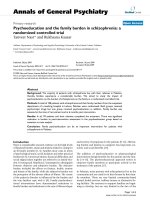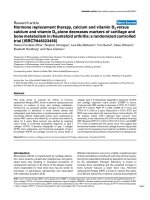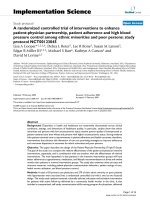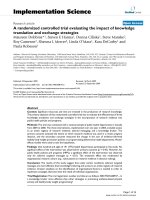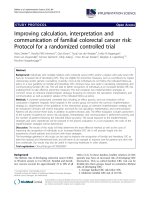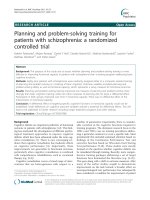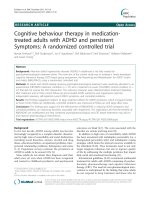Yoga intervention and reminder e-mails for reducing cancer-related fatigue - a study protocol of a randomized controlled trial
Bạn đang xem bản rút gọn của tài liệu. Xem và tải ngay bản đầy đủ của tài liệu tại đây (479.54 KB, 7 trang )
Zetzl et al. BMC Psychology
(2019) 7:64
/>
STUDY PROTOCOL
Open Access
Yoga intervention and reminder e-mails for
reducing cancer-related fatigue - a study
protocol of a randomized controlled trial
Teresa Zetzl1* , Michael Schuler2, Agnes Renner1, Elisabeth Jentschke1 and Birgitt van Oorschot1
Abstract
Background: Almost 90% of cancer patients suffer from symptoms of fatigue during treatment. Supporting
treatments are increasingly used to alleviate the burden of fatigue. This study examines the short-term and longterm effects of yoga on fatigue and the effect of weekly reminder e-mails on exercise frequency and fatigue
symptoms.
Methods: The aim of the first part of the study will evaluate the effectiveness of yoga for cancer patients with
mixed diagnoses reporting fatigue. We will randomly allocate 128 patients to an intervention group (N = 64)
receiving yoga and a wait-list control group (N = 64) receiving yoga 9 weeks later. The yoga therapy will be
performed in weekly sessions of 60 min each for 8 weeks. The primary outcome will be self-reported fatigue
symptoms. In the second part of the study, the effectiveness of reminder e-mails with regard to the exercise
frequency and self-reported fatigue symptoms will be evaluated. A randomized allocated group of the participants
(“email”) receives weekly reminder e-mails, the other group does not. Data will be assessed using questionnaires the
beginning and after yoga therapy as well as after 6 months.
Discussion: Support of patients suffering from fatigue is an important goal in cancer patients care. If yoga therapy
will reduce fatigue, this type of therapy may be introduced into routine practice. If the reminder e-mails prove to
be helpful, new offers for patients may also develop from this.
Trial registration: German Clincial Trials Register (DRKS00016034, 12/2018), retrospectively registered.
Keywords: Cancer, Fatigue, Yoga, Reminder e-mails, Supportive therapy, Randomized controlled trial
Background
Cancer-related fatigue (CrF) is the most common symptom
of cancer treatment. Up to 90% of oncological patients suffer from fatigue during treatment [1, 2]. Both physiological
and psychosocial factors play an important role in the
development of fatigue. Often, however, no specific cause
can be identified and therefore no specific treatment can be
offered. In these cases, additional support services should
be provided to help patients to cope with symptoms of
fatigue. These range from drug treatment approaches psychosocial counseling, psychoeducation, exercise training to
so-called mind-body interventions [2].
* Correspondence:
1
Interdisciplinary Center, Palliative Medicine, University Hospital Wuerzburg,
Josef-Schneider-Str. 2, 97080 Wuerzburg, Germany
Full list of author information is available at the end of the article
CrF is characterized by an intense and chronic sense
of tiredness and exhaustion that is not associated with
previous stress and cannot completely be relieved by
rest. This tiredness can be found on three levels: physical, emotional and cognitive. In order to manage the
fatigue symptoms on all three levels, results of meta-analyses support a multimodal approach of cognitive, physical and emotional aspects to symptom relief [3], for
example consisting of psychoeducation and mind-body
intervention. Few findings on the efficacy of psychoeducative interventions covering cognitive and emotional
aspects and behavioral techniques on fatigue symptoms
in cancer patients exist [4–6]. With regard to mind-body
interventions (physical and emotional aspects), there are
predominantly findings that speak for their efficacy in
fatigue. The term “mind-body intervention” refers to
© The Author(s). 2019 Open Access This article is distributed under the terms of the Creative Commons Attribution 4.0
International License ( which permits unrestricted use, distribution, and
reproduction in any medium, provided you give appropriate credit to the original author(s) and the source, provide a link to
the Creative Commons license, and indicate if changes were made. The Creative Commons Public Domain Dedication waiver
( applies to the data made available in this article, unless otherwise stated.
Zetzl et al. BMC Psychology
(2019) 7:64
interventions that aim to strengthen self-care through
active and health-promoting strategies. With regard to
fatigue, the focus here is mostly on mindfulness-based
procedures, meditations as well as Yoga or QiGong. A
meta-analysis reports a moderate effect of mind-body
interventions on fatigue symptoms [7]. Both the ‘Mindfulness-Based Stress Reduction Program’ (MBSR) by
John Kabat-Zinn [8–10] and yoga interventions [11–14]
or Pranayama [15] help reducing fatigue. Even compared
to a supportive or psychoeducative group of patients
with fatigue, yoga therapy showed significant effects
[16]. However, there are also contradictory findings that
do not support significant differences in fatigue symptoms through yoga intervention compared to a control
group [17–19].
Follow-up findings for mind-body interventions dealing
with fatigue vary widely. While some randomized controlled trials (RCT) show significant effects in fatigue
following a mind-body intervention, but no longer after 3
months [12, 20], others found no effects immediately after
an intervention, but 3 months later [21]. Lengacher et al.
[22] showed significant reduction of fatigue compared to a
CG after the intervention and also in a catamnesis 6 weeks
later [22]. An observational study showed significant longterm effects of mind-body intervention regarding depression and general mood after 1 year, but no long term effects
regarding fatigue [23].
The yoga therapy intervention we used in our study
was already evaluated in previous studies. Using a randomized controlled design, Lundt et al. [24] showed that
this kind of yoga therapy significantly reduce anxiety in
cancer patients with mean to high effect size (d = 0.75).
However, no effects significant effects were found for fatigue and depression [24]. In an observational, catamnestic study without control group based on the study
above, 6 months after yoga intervention significant
changes in fatigue (d = 0.32), anxiety (d = 0.33) and
depression (d = 0.40) were observed compared to baseline measurement [25].
An important moderator of the effect on fatigue is
frequency in exercising of the patients during and after
the intervention [19, 21]. To improve exercise frequencies, participants often receive exercise CDs and/or
exercise books at the end of yoga intervention [11, 16,
18–20]. Documentation of their daily exercise duration
in addition to the exercise CD has also shown to be
helpful for the sustainability of the effects [21]. In the
area of oncological complementary therapy, supporting
participants via phone calls at weekends within an ongoing mind-body intervention helps to maintain the
continuity of the exercises [26]. In the medical context,
daily reminder e-mails increased adherence to medication [27, 28]. However, there are no comparable studies
on mind-body procedures to improve fatigue symptoms
Page 2 of 7
that use weekly reminder e-mails to promote sustainable effects.
In this study, the following research questions will be
examined:
Primary research question:
1. Does an 8-week yoga intervention (IG) reduce selfreported fatigue symptoms directly after the
intervention compared to a waiting-list control
group (CG)? We expect an effect of d = 0.50 in
favor of the IG.
Secondary research questions
2. Do gender, age, cancer, baseline fatigue, depression
and period since first diagnosis moderate the effects
of the yoga intervention on self-reported fatigue?
3. Do reminder-e-mails after the yoga intervention
reduce self-reported fatigue symptoms and improve
exercise frequency compared to participants of the
yoga-intervention receiving no reminder e-mails?
4. Is exercise frequency associated with lower selfreported fatigue symptoms?
Methods
The study will take place in the premises of the University
Hospital Wuerzburg Radiotherapy/Palliative Care Unit.
Written informed consent will be obtained from all participants. To answer the research questions, a combination of
two RCTs will be implemented (see Fig. 1). In the first part,
eligible patients will be randomized to the IG (8-week yoga
intervention) or CG. The CG will also receive the yoga
intervention, but nine weeks later than the IG. At the end
of the yoga intervention, the second RCT will be implemented: all patients will be again randomized to get reminder-emails (email group) or no reminder emails after
the yoga-interventions. The email group will receive a
weekly email over 24 weeks a week, in which one asana out
of the yoga intervention is repeated and described in detail.
In addition, through the reminder-email participants will be
encouraged to practice by themselves regularly. The first
RCT is described in 2.1 and will be used to answer research
questions 1 and 2, the second RCT is described in 2.2 and
will be used to answer research questions 3 and 4.
First RCT (yoga intervention)
Study-setting and eligibility criteria
The participants will be at least 18 years old, will have a
previous oncological disease and will undergo treatment
at the radiotherapy outpatient clinic or the interdisciplinary oncological therapy outpatient clinic (IOT) at the
time of screening and they report fatigue in Fischer
screening (intensity ≥4, impairment ≥5). Exclusion
criteria will be insufficient knowledge of German and
Zetzl et al. BMC Psychology
(2019) 7:64
Page 3 of 7
Fig. 1 Study design; Abbreviations: IOT = interdisciplinary oncological therapy outpatient clinic; RAD = radiation therapy ambulance; R = Randomization;
IG = Intervention group, CG = Control group TAU = treatment as usual
severe emotional or physical impairment as well as more
than 50 km distance to the university hospital which
would require travelling.
Study design and measurement occasions
Eligible patients will receive the first set of questionnaires as a baseline assessment (T0). All participants will
receive psychoeducation intervention (coping with
fatigue). Subsequently, they will be randomized to IG or
CG. The IG starts with the yoga intervention 1 week
after T0, the CG starts 10 weeks after T0. The yoga
intervention will be conducted for 8 weeks plus an
additional lesson in the ninth week to give the participants the opportunity to catch up on a missed session.
Primary and secondary outcomes will be assessed 10
weeks after the start of yoga intervention (T1) via questionnaires. Participants of the CG will also answer a
questionnaire at the begin of the yoga intervention (T1)
and at the end of the yoga intervention (T2, this will be
used in the second RCT).
every hour and helps to encourage the participants to
deal gently with their bodies. Participants should not
perform any physical exercises that cause pain. The
subsequent body exercises are structured from lying to
sitting to standing. The following sequence of exercises
will be repeated in each yoga unit: 1) Relaxation:
conscious breathing, body scan, mindfulness 2) Vein
pump 3) Pelvis and back rotation (adapted variation of
the “nakrasana”) 4) Pelvis opening (adapted variation of
the “supta baddha konasana”) 5) Shoulder bridge (“setu
bandha sarvangasana”) 6) Forward folds (Paschimottanasana and variations with Pranayama) 7) Backbend:
intense east stretch (Purvottasana) 8) Diagonal static
yoga cat (Majariasana 1 and resting pose) 9) Standing
exercise 10) Upward Salute(Urdhva Hastasana) 11)
Warrior 1 (Virabhadrasana 1) 12) Warrior 3 (Virabhadrasana 3) 13) Tree (Vrkasana variation) 14) Relaxation
(Savasana). In all exercises, participants are reminded
to breathe slowly, deeply and consciously. Adverse
events and complications during yoga therapry are
recorded by yoga teachers on a standardized basis.
Yoga-intervention
Certified yoga teachers will carry out yoga intervention.
The sequence of exercises will remain constant from
beginning to end. The asanas (physical exercises from
Yoga) were inspired by John-Kabat Zinn and adopted
for cancer patients by Dr. Jentschke (psychooncologist,
physiotherapist and yoga teacher). One yoga session
will last 1 hour. It consists of physical exercises
(asanas), conscious breathing (Pranayama) and deep
relaxation (Savasana). Nonviolence (ahimsa) as an
important basic principle of yoga is to be repeated
Sample size calculation
Two randomized intervention studies investigating yoga
therapies in cancer patients of comparable type and duration using an intervention condition and a waiting-list
control group condition produced intergroup effect size in
fatigue self-assessment scales of d = 0.66 [29] and d = 0.51
[18]. Based on the lower effect size of d = 0.50 alpha = 0.05
and Power = 0.80 result in a case number of n = 64 per
group, i.e. 128 patients in total, for a t-test for independent
samples with two-sided testing.
Zetzl et al. BMC Psychology
(2019) 7:64
Recruitment
Oncological patients from the radiotherapy outpatient
clinic and the interdisciplinary oncological therapy outpatient clinic who score high in fatigue screening will be
invited to a non-binding event via mail where they will
receive further information on the study. If no response
is received within a week of the invitations being sent,
patients will be contacted again by telephone to clarify
any ambiguities. Through this recruitment, we hope to
maximize participation rate in the first information
event. At the first event, the patients will be explained
the purpose and procedure of the study and asked to
participate in the study.
Randomization
The information events will take place every 4 weeks. The
participants of the study will be recruited on each information event. All patients who met inclusion criteria will
be asked to participate. Participants who will have signed
the consent form and completed the first questionnaire
set will be randomly assigned to the IG or CG. To ensure
that enough patients will be randomized to the intervention group to perform the intervention, a block
randomization procedure will be used. Patients meeting
the same information event will form a block. The
randomization list with computer-generated numbers will
be created by the Institute of Clinical Epidemiology and
Biometry of the university of Wuerzburg.
Second RCT (reminder e-mails)
Study design and measurement occasions
After the yoga intervention, all participants are randomly assigned to group “Email” who will get weekly
reminder e-mail or to group “NoEmail” who will
receive no reminder e-mails. Participants of both
groups will receive a practice book and a practice CD.
Outcomes will be assessed 6 months after the end of
the yoga therapy (T3).
Reminder e-mail
Reminder e-mails are used for the second question. The
e-mails in the first 12 weeks contain descriptions of the
twelve asanas - one asana each week - and an encouragement to practice yoga during this week. The asanas
are described analogously to the order of the yoga classes. In the following 12 weeks, the 12 reminder e-mails
will be repeated in the same order.
Randomization
All participants of the Yoga study will be randomly
assigned to the group “Email” or “NoEmail”. A block
randomization procedure will be used. Patients assigned
to a group (IG or CG) after the information event form
a block. The randomization list with computer-
Page 4 of 7
generated numbers is compiled by staff members of the
interdisciplinary Palliative Medicine Centre.
Outcomes, ethics, data management and statistics
Outcomes and other measures
Outcomes will be assessed using patient questionnaires
or will be extracted from the patient-documentation
system. Unless otherwise specified, all outcomes are
recorded at all measurement times (T0, T1, T2, T3).
Primary outcome: self-reported fatigue
Self-reported fatigue will be assessed using the German
version of EORTC QLQ-FA13 13 Items (European
Organization for Research and Treatment of Cancer Quality of Life Questionnaire – Fatigue) [30]. This questionnaire can be used in all tumor diseases in all stages
and phases of the disease and in all areas of treatment
(chemotherapy, radiation, surgery) or care (acute care,
rehabilitation, aftercare or palliative care) [31]. Fatigue is
measured using 13 items. Response categories of all
items are ‘not at all’, ‘a little’, ‘quite a bit’, and ‘very
much’, coded with scores from 1 to 4. All Items are
summed up to one fatigue score. The scores range from
0 to 100. Higher values indicate a higher level of fatigue
symptoms. The internal consistency for the German
version was good with Cronbach’s alpha values ranging
from .79–.90 [30, 32].
Secondary outcomes
Depression The Patient Health Questionnaire (PHQ-9)
will be used to assess depression. The 9 items assess
depression symptoms according to DSM-IV/DSM-V and
are scored on a 4-point Likert scale (0 = not at all, 1 =
several days; 2 = more than half of the days; 3 = nearly all
days). All items are summed up to one sum score, ranging
from (0–27). Higher values indicate higher depression. The
internal consistency for the PHQ-9 proved to be good with
Cronbach’s α = 0.79 for cancer patients [33].
Quality of life The EORTC QLQ-C15-PAL is a short
form [34] of the QLQ-C30 for palliative care settings.
The 15 items of the questionnaire assess nine categories:
physical function, emotional function, global QoL, pain,
fatigue, appetite, dyspnea, constipation, and sleep. The
four response categories are coded with scores from 1 to
4 (1: not at all; 2: a little; 3: quite a bit; 4: very much)
and are transformed to a 0–100 scale range.As an exception, global QoL is scored from 1 (very poor) to 7 (excellent). A higher score represents better function and
QOL, while for symptom scale, it indicates greater
symptom burden.
Zetzl et al. BMC Psychology
(2019) 7:64
Symptom assessment The German version of the
Edmonton Symptom Assessment Scale (ESAS) [35] will
be used to assess symptom severity. The nine symptoms
pain, fatigue, nausea, sadness, anxiety, drowsiness, appetite, general condition and shortness of breath are
assessed on a numerical rating scale from 0 = none to
10 = worst possible. Higher values in the summed scale
score indicate high symptom burden. The internal
consistency according to Cronbach’s alpha range
between 0.67–0.73 [35].
Distress thermometer The distress thermometer is
used to measure psychosocial stress. It uses a numeric
rating scale ranging from 0 (no distress) to 10 (extreme
distress) and is widely used in clinical practice [36]. A
cut-off value of ≥5 is referred to as high distress. Both
the dichotomous classification and the sum score of the
district thermometer are to be recorded in the study. As
a short screening instrument, the Distress Thermometer
is well suitable for identifying high loads recorded by
Hospital Anxiety and Depression Scale > 11 (AUC values
0.71–0.76) [36].
Sense of coherence The German version of the short
form of Sense of Coherence Scale (SOC L9) [37] will
be used to record the sense of coherence. This is a
reliable, valid and economic alternative short form of
the SOC developed by Antonovsky (1983). The 9
items are scored on an 8-point Likert scale. Response
formats vary between items. Higher values indicate a
high degree of coherence, whereby age- and genderdependent norms must be applied. The internal
consistency of the SOC L9 can be rated as good
(Cronbach’s alpha = .87) [37].
Sociodemographic and health data The following
socio-demographic data will be assessed at T0: age,
gender, marital status, number of children, level of education, professional status. Individual coping with the
tumor disease, treatment status and use of analgesics
and psychopharmaceuticals will be assessed at each
measurement occasion. In addition, previous experience
with yoga and expectations of the participants on yoga
will be asked at T0.
Program evaluation and training time At the end of
the intervention (IG: T1; CG: T2), participants comprehensibility and applicability of the yoga theory and psychoeducation as well as subjective benefit will be
assessed on a scale from 0 (not at all) to 3 (very). Furthermore, the current scope of the exercise duration
(yoga) and the application frequency of the recommendations for handling fatigue will be measured at T1(IG)/
Page 5 of 7
T2(CG) and T3(IG and CG). Reasons for continuing or
ending yoga practice are documented.
Data management and confidentiality
In order to guarantee the confidentiality of data, the data
will be pseudonymized using an allocation list. A
research code will be assigned to each study participant
so that only the code and no personal data will be used
on all questionnaires. All questionnaires will be kept in
locked cabinets and/or password protected computers.
The allocation list will be only accessible to the data
manager of the University Hospital Wuerzburg responsible for allocating medical data. The allocation
list is deleted after the end of the study. It will contain the name, address, date of birth, SAP research
number and contact data of the patients. During the
period of this assignment, the research data will be
considered “personal data” and the data protection
laws are to be complied. The questionnaires will be
scanned by the software EvaSys. The data will be
exported to statistical programs for further statistical
analysis. The data manager will compare the transferred data of the questionnaires item by item with
the original questionnaires. Additional data, such as
treatment duration and intensity, will be taken from
the electronic patient file. The data manager will also
advise on storage, back up and archiving of data to
ensure databases are regularly backed up to ensure
data is safeguarded from accidental loss. The study
master file and all study documentation will be archived for at least 10 years.
Statistical analysis
To answer the first research question, analyses of covariance (ANCOVA) will be performed, using fatigue score T1
(primary outcome) as dependent variable, type of treatment
(IG vs. CG) as independent variable and fatigue at baseline
as covariate. The second research question will be analyzed
by including the moderator (e.g. gender, age) and the interaction terms (for example group X gender) in the model.
The third research question will be tested again by
using ANCOVA, with fatigue T3 as dependent variable,
fatigue after the intervention (IG: T1, CG: T2) as covariate and type of reminder (e-mail vs. no email) as independent variable. The fourth research question will be
tested by computing a mediation model using structural
equation modeling framework [38, 39].
Ethics, consent and permission
The investigation will conform to the principles outlined
in the Declaration of Helsinki. The study protocol was
approved by the Ethics Committee of the University
Wuerzburg on 15/05/2018 (Nr. 59/18 sc). If interested,
all potential participants will receive detailed written
Zetzl et al. BMC Psychology
(2019) 7:64
information on all relevant aspects of the study. Participants will be informed that they could withdraw from
the study at any given time and without reason and that
participation in the study is voluntary. Participants will
be assured that any future treatment will not be affected
in any way should they choose to withdraw. The
patients will consent to the study after detailed information. The study is registered on German Clincial
Trials Register (DRKS00016034, 12/2018). This paper
contains the original study protocol. Material changes
to the study protocol will be submitted to the Ethics
Committee of the University of Wuerzburg for approval. These changes are documented in detail in
the German Register of Clinical Trials and described
transparently in study reports.
Discussion
Many cancer patients report fatigue as a very negative
stressful side effect at the simultaneous time strong perceived helplessness. In this study, we will offer demandoriented psychoeducation and Yoga therapy to patients
of all tumor entities who suffer from fatigue. The effect
of psychoeducation with yoga is compared to psychoeducation without yoga. To our knowledge, the combination of psychoeducation and yoga therapy is an
innovation that follows the multidimensional approach
for overcoming fatigue. Exploratively, the results of this
study (yoga plus psychoeducation) can be compared
with other studies (yoga only) at the Interdisciplinary
Center for Palliative Medicine. By including different
tumor entities, this study can provide indications as to
which patients with which tumor entities can benefit
most from yoga therapy. So other hypotheses can be
generated, such as the degree of fatigue that patients
benefit most from the intervention, whether there are
differences between the different tumor types in terms
of the benefit and feasibility of the intervention, or to
what extent tumor therapy has an influence on the
intervention.
At the same time, it is to be examined to what degree
reminder e-mails are helpful for the sustainability of the
practice time for yoga exercises 6 months after yoga
therapy. In addition, the relationship between exercise
frequency and the extent of fatigue symptoms will be
examined.
If yoga therapy proves to be supportive for oncological
patients and reduces fatigue, this type of therapy should
continue to be introduced into routine practice. If differences in the effectiveness of yoga therapy are found in
different patient groups, it should be considered whether
yoga therapy needs to be adapted to specific patient
needs. Further studies should also be conducted to
determine the barriers to participation in yoga therapy.
The aim is to develop a supportive program for
Page 6 of 7
oncological patients that is as adapted as possible to
their needs.
If the reminder e-mails prove to be helpful with regard
to exercise frequency and fatigue symptoms, new offers
for patients may also develop from this. For example,
the focus is on internet-based training sessions or independent yoga exercises at home.
The findings of this study will be published in peerreviewed journals and will be presented in conferences.
Abbreviations
CG: control group; CrF: Cancer related Fatigue; EORTC QLQ C15
PAL: European Organization for Research and Treatment of Cancer - Quality
of Life Questionnaire – Palliative; EORTC QLQ FA: European Organization for
Research and Treatment of Cancer - Quality of Life Questionnaire – Fatigue;
ESAS: Edmonton Symptom Assessment Scale; IG: Intervention group;
IOT: Interdisciplinary oncological therapy outpatient clinic;
MBSR: Mindfulness-based stress reduction; PHQ-9: Patient Health
questionnaire; QoL: Quality of life; RCT: Randomized controlled trial;
SOC: Sense of coherence
Acknowledgments
Not applicable.
Authorsʼ contributions
vOB TZ EJ MS developed the study design. vOB initiated the study and
obtained funding. TZ supervises the study and data collection TZ wrote the
first draft of the manuscript, which was critically reviewed by MS and AR. All
authors finally read and approved the manuscript for submission. TZ and AR
participate in conducting the study and in data collection. MS participates in
conducting the study and developing the design and statistical analysis plan.
Study status
Recruiting has started and is ongoing.
Funding
This work is supported by the Deutsche Krebshilfe, Buschstr. 32, 53113 Bonn.
Funding covers costs for personal, materials and traveling expenses. As a
sponsor, Deutsche Krebshilfe plays no role in the study design, collection,
analysis, interpretation or writing of the manuscript. DKH has peer-reviewed
the study protocol. This publication was funded by the German Research
Foundation (DFG) and the University of Wuerzburg in the funding
programme Open Access Publishing.
Availability of data and materials
Not applicable.
Ethics approval and consent to participate
The investigation conforms to the principles outlined in the Declaration of
Helsinki. The study protocol was approved by the Ethics Committee of the
University Würzburg on 15/05/2018 (Nr. 59/18 sc). Eligible patients will
receive written information about all relevant aspects of the study and that
their participation in the study is voluntary and they have the right to refuse
or to withdraw their consent at any time without reprisals. Patients
providewritten informed consent. The study has been registered with the
German Clinical Trials Register DRKS00016034). This paper contains the
original study protocol. Any substantial modifications to the study protocol
will be submitted to the Ethics Committee of the University Würzburg for
approval prior to implementation. These amendments will be documented
in detail in the German Clinical Trials Register and will be described
transparently in trial reports.
Consent for publication
Not applicable.
Competing interests
The authors declare that they have no competing interests.
Zetzl et al. BMC Psychology
(2019) 7:64
Author details
1
Interdisciplinary Center, Palliative Medicine, University Hospital Wuerzburg,
Josef-Schneider-Str. 2, 97080 Wuerzburg, Germany. 2Institute of Clinical
Epidemiology and Biometry, University of Wuerzburg, Josef-Schneider-Str. 2,
97070 Wuerzburg, Germany.
Received: 12 July 2019 Accepted: 3 September 2019
References
1. Körner P, Ehrmann K, Hartmannsgruber J, Metz M, Steigerwald S, Flentje M,
van Oorschot B. Patient-reported symptoms during radiotherapy.
Strahlenther Onkol. 2017;193:570–7.
2. Berger AM, Mooney K, Alvarez-Perez A, Breitbart WS, Carpenter KM, Cella D,
et al. Cancer-related fatigue, version 2.2015. J Natl Compr Canc Ne. 2015;13:
1012–39.
3. Kangas M, Bovbjerg DH, Montgomery GH. Cancer-related fatigue: a
systematic and meta-analytic review of non-pharmacological therapies for
cancer patients. Psychol Bull. 2008;134:700–41.
4. Reif K, de Vries U, Petermann F, Görres S. A patient education program is
effective in reducing cancer-related fatigue: a multi-Centre randomised twogroup waiting-list controlled intervention trial. Eur J Oncol Nurs. 2013;17:
204–13.
5. Duijts SF, Mizja F, Oldenburg Hester S, van Marc B, Neil A. Effectiveness of
behavioral techniques and physical exercise on psychosocial functioning
and health-related quality of life in breast cancer patients and survivors—a
meta-analysis. Psycho-Oncol. 2011;20:115–26.
6. Gielissen MFM, Verhagen S, Witjes F, Bleijenberg G. Effects of cognitive
behavior therapy in severely fatigued disease-free cancer patients compared
with patients waiting for cognitive behavior therapy: a randomized
controlled trial. J Clin Oncol. 2006;24:4882–7.
7. Buffart LM, van Uffelen JGZ, Riphagen II, Brug J, van Mechelen W, Brown
WJ, Chinapaw MJM. Physical and psychosocial benefits of yoga in cancer
patients and survivors, a systematic review and meta-analysis of randomized
controlled trials. BMC Cancer. 2012;12:559. />8. Rahmani S, Talepasand S. The effect of group mindfulness - based stress
reduction program and conscious yoga on the fatigue severity and global
and specific life quality in women with breast cancer. Med J Islam Repub
Iran. 2015;29:175.
9. Ledesma D, Kumano H. Mindfulness-based stress reduction and cancer: a
meta-analysis. Psycho-Oncol. 2008;18:571–9.
10. Kabat-Zinn J, Massion AO, Kristeller J, Peterson LG, Fletcher KE, Pbert L, et al.
Effectiveness of a meditation-based stress reduction program in the
treatment of anxiety disorders. Am J Psychiat. 1992;149:936–43.
11. Carson JW, Carson KM, Porter LS, Keefe FJ, Seewaldt VL. Yoga of awareness
program for menopausal symptoms in breast cancer survivors: results from
a randomized trial. Support Care Cancer. 2009;17:1301–9.
12. Cramer H, Rabsilber S, Lauche R, Kummel S, Dobos G. Yoga and meditation
for menopausal symptoms in breast cancer survivors-a randomized
controlled trial. Cancer. 2015;121:2175–84.
13. Bower JE, Greendale G, Crosswell AD, Garet D, Sternlieb B, Ganz PA, et al.
Yoga reduces inflammatory signaling in fatigued breast cancer survivors: a
randomized controlled trial. Psychoneuroendocrino. 2014;43:20–9.
14. Banasik J, Williams H, Haberman M, Blank SE, Bendel R. Effect of Iyengar
yoga practice on fatigue and diurnal salivary cortisol concentration in breast
cancer survivors. J Am Acad Nurse Prac. 2011;23:135–42.
15. Chakrabarty J, Vidyasagar M, Fernandes D, Joisa G, Varghese P, Mayya S.
Effectiveness of pranayama on cancer-related fatigue in breast cancer
patients undergoing radiation therapy: a randomized controlled trial. Int J
Yoga. 2015;8:47–53.
16. Vadiraja HS, Rao RM, Nagarathna R, Nagendra HR, Patil S, Diwakar RB, et al.
Effects of yoga in managing fatigue in breast Cancer patients: a randomized
controlled trial. Indian J Palliat Care. 2017;23:247–52.
17. Culos-Reed NS, Carlson LE, Daroux L, Hately-Aldous S. A pilot study of yoga
for breast cancer survivors: physical and psychological benefits. PsychoOncol. 2005;15:891–7.
18. Chandwani KD, Thornton B, Perkins GH, Arun B, Raghuram NV, Nagendra HR,
et al. Yoga improves quality of life and benefit finding in women undergoing
radiotherapy for breast cancer. J Soc Integr Oncol. 2010;8:43–55.
Page 7 of 7
19. Moadel AB, Shah C, Wylie-Rosett J, Harris MS, Patel SR, Hall CB, Sparano JA.
Randomized controlled trial of yoga among a multiethnic sample of breast
cancer patients: effects on quality of life. J Clin Oncol. 2007;25:4387–95.
20. Bower JE, Crosswell AD, Stanton AL, Crespi CM, Winston D, Arevalo J, et al.
Mindfulness meditation for younger breast cancer survivors: a randomized
controlled trial. Cancer. 2015;121:1231–40. />21. Kiecolt-Glaser JK, Bennett JM, Andridge R, Peng J, Shapiro CL, Malarkey WB,
et al. Yoga's impact on inflammation, mood, and fatigue in breast Cancer
survivors: a randomized controlled trial. J Clin Oncol. 2014;32:1040–9.
22. Lengacher CA, Reich RR, Paterson CL, Ramesar S, Park JY, Alinat C, et al.
Examination of broad symptom improvement resulting from mindfulnessbased stress reduction in breast Cancer survivors: a randomized controlled
trial. J Clin Oncol. 2016;34:2827–34.
23. Kieviet-Stijnen A, Visser A, Garssen B, Hudig W. Mindfulness-based stress
reduction training for oncology patients: patients’ appraisal and changes in
well-being. Patient Educ Couns. 2008;72:436–42.
24. Hardoerfer K, Jentschke E. Effect of yoga therapy on symptoms of anxiety in
Cancer patients. Oncol Res Treat. 2018. />25. Lundt A, Jentschke E. Long-term changes of symptoms of anxiety,
depression, and fatigue in Cancer patients 6 months after the end of yoga
therapy. Integr Cancer Ther. 2019;18:1534735418822096.
26. Banerjee B, Vadiraj HS, Ram A, Rao R, Jayapal M, Gopinath KS, et al. Effects
of an integrated yoga program in modulating psychological stress and
radiation-induced genotoxic stress in breast cancer patients undergoing
radiotherapy. Integr Cancer Ther. 2007;6:242–50.
27. Fox MC, Creinin MD, Murthy AS, Harwood B, Reid LM. Feasibility study of
the use of a daily electronic mail reminder to improve oral contraceptive
compliance. Contraception. 2003;68:365–71.
28. Haramiova Z, Stasko M, Hulin M, Tesar T, Kuzelova M, Morisky DM. The
effectiveness of daily SMS reminders in pharmaceutical care of older adults
on improving patients' adherence to antihypertensive medication (SPPA):
study protocol for a randomized controlled trial. Trials. 2017;18:334.
29. Danhauer SC, Mihalko SL, Russell GB, Campbell CR, Felder L, Daley K, Levine
EA. Restorative yoga for women with breast cancer: findings from a
randomized pilot study. Psycho-Oncol. 2009;18:360–8.
30. Weis J, Tomaszewski KA, Hammerlid E, Ignacio Arraras J, Conroy T, Lanceley
A, et al. International psychometric validation of an EORTC quality of life
module measuring Cancer related fatigue (EORTC QLQ-FA12). J Natl Cancer
I. 2017;109.
31. Weis J. Diagnostik und Erfassung der tumorassoziierten fatigue. Forum.
2013;28:39–42.
32. Fuhrmann K, Mehnert A, Geue K, Hinz A. Fatigue in breast cancer patients:
psychometric evaluation of the fatigue questionnaire EORTC QLQ-FA13.
Breast Cancer. 2015;22:608–14.
33. Hartung TJ, Friedrich M, Johansen C, Wittchen H-U, Faller H, Koch U, et al.
The hospital anxiety and depression scale (HADS) and the 9-item patient
health questionnaire (PHQ-9) as screening instruments for depression in
patients with cancer. Cancer. 2017;123:4236–43.
34. Groenvold M, Petersen MA, Aaronson NK, Arraras JI, Blazeby JM, Bottomley A,
et al. The development of the EORTC QLQ-C15-PAL: a shortened questionnaire
for cancer patients in palliative care. Eur J Cancer. 2006;42:55–64.
35. Stiel S, Matthes ME, Bertram L, Ostgathe C, Elsner F, Radbruch L. Validation
of the new version of the minimal documentation system (MIDOS) for
patients in palliative care: the German version of the Edmonton symptom
assessment scale (ESAS). Schmerz. 2010;24:596–604.
36. Mehnert A, Müller D, Lehmann C, Koch U. Die deutsche version des NCCN
distress-thermometers. Z Psychiar Psych Ps. 2006;54:213–23.
37. Schumacher J, Brähler E. Sense of Coherence Scale -Leipziger Kurzform
(SOC-L9). Online-Datenbank Assessment. Institut für Qualitätssicherung in
Prävention und Rehabilitation an der Deutschen Sporthochschule Köln
(IQPR). 2004.
38. Preacher KJ, Hayes AF. SPSS and SAS procedures for estimating indirect
effects in simple mediation models. Behav Res Meth Ins C. 2004;36:717–31.
39. Mackinnon DP, Lockwood CM, Williams J. Confidence limits for the indirect
effect: distribution of the product and resampling methods. Multivariate
Behav Res. 2004;39:99.
Publisher’s Note
Springer Nature remains neutral with regard to jurisdictional claims in
published maps and institutional affiliations.
